外文翻译---废杂铜的回收与利用
- 格式:docx
- 大小:47.49 KB
- 文档页数:9
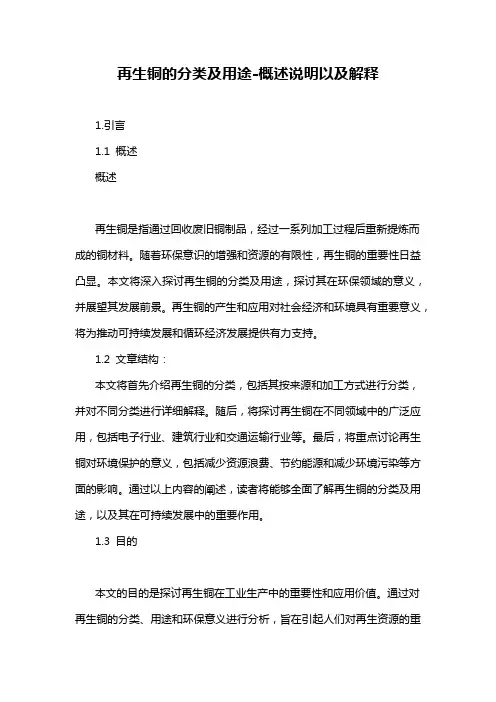
再生铜的分类及用途-概述说明以及解释1.引言1.1 概述概述再生铜是指通过回收废旧铜制品,经过一系列加工过程后重新提炼而成的铜材料。
随着环保意识的增强和资源的有限性,再生铜的重要性日益凸显。
本文将深入探讨再生铜的分类及用途,探讨其在环保领域的意义,并展望其发展前景。
再生铜的产生和应用对社会经济和环境具有重要意义,将为推动可持续发展和循环经济发展提供有力支持。
1.2 文章结构:本文将首先介绍再生铜的分类,包括其按来源和加工方式进行分类,并对不同分类进行详细解释。
随后,将探讨再生铜在不同领域中的广泛应用,包括电子行业、建筑行业和交通运输行业等。
最后,将重点讨论再生铜对环境保护的意义,包括减少资源浪费、节约能源和减少环境污染等方面的影响。
通过以上内容的阐述,读者将能够全面了解再生铜的分类及用途,以及其在可持续发展中的重要作用。
1.3 目的本文的目的是探讨再生铜在工业生产中的重要性和应用价值。
通过对再生铜的分类、用途和环保意义进行分析,旨在引起人们对再生资源的重视和利用。
同时,希望通过本文的研究,提高大众对再生铜的认识,促进再生铜产业的发展,推动可持续发展理念的实践和推广。
最终达到保护环境、节约资源、促进经济发展的综合目的。
2.正文2.1 再生铜的分类再生铜主要根据不同的来源和处理方式可以分为几种分类。
一般来说,再生铜可以分为两大类:工业废铜和废旧铜制品。
一、工业废铜工业废铜主要来自于生产和加工过程中的废弃铜材料,如废旧电线、废旧电缆、废旧电器、废旧管道等。
根据不同的形态和成分,工业废铜又可进一步分为以下几种类型:1. 废旧电线:包括裸铜电线、绝缘电线、电焊丝等。
2. 废旧电缆:包括铜芯电力电缆、铜芯通信电缆等。
3. 废旧电器:如废旧电机、废旧变压器、废旧电磁铁等。
4. 废旧管道:如废旧水暖管、废旧空调管道等。
二、废旧铜制品废旧铜制品是指由铜材料制成的废旧产品,如废旧铜锅、废旧铜器、废旧铜带等。
废旧铜制品的回收和再利用可以减少资源浪费,节约能源,并且有利于环境保护。
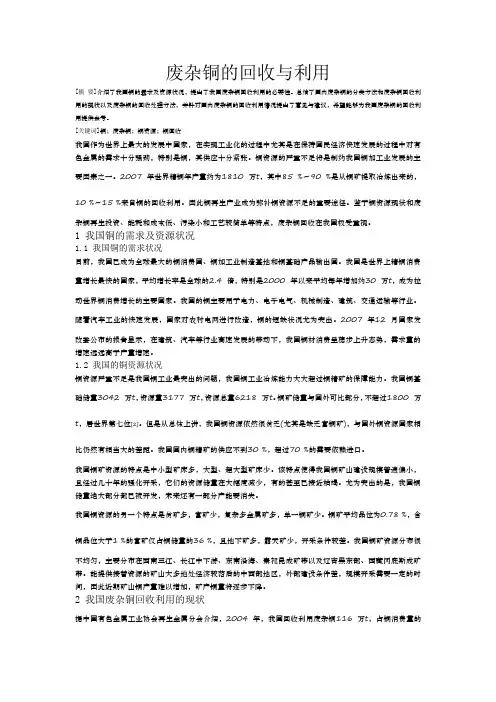
废杂铜的回收与利用[摘要]介绍了我国铜的需求及资源状况,提出了我国废杂铜回收利用的必要性。
总结了国内废杂铜的分类方法和废杂铜回收利用的现状以及废杂铜的回收处理方法,并针对国内废杂铜的回收利用情况提出了意见与建议,希望能够为我国废杂铜的回收利用提供参考。
[关键词]铜;废杂铜;铜资源;铜回收我国作为世界上最大的发展中国家,在实现工业化的过程中尤其是在保持国民经济快速发展的过程中对有色金属的需求十分强劲,特别是铜,其供应十分紧张。
铜资源的严重不足将是制约我国铜加工业发展的主要因素之一。
2007 年世界精铜年产量约为1810 万t,其中85 %~90 %是从铜矿提取冶炼出来的,10 %~15 %来自铜的回收利用。
因此铜再生产业成为弥补铜资源不足的重要途径。
鉴于铜资源现状和废杂铜再生投资、能耗和成本低、污染小和工艺较简单等特点,废杂铜回收在我国极受重视。
1 我国铜的需求及资源状况1.1 我国铜的需求状况目前,我国已成为全球最大的铜消费国、铜加工业制造基地和铜基础产品输出国。
我国是世界上精铜消费量增长最快的国家,平均增长率是全球的2.4 倍,特别是2000 年以来平均每年增加约30 万t,成为拉动世界铜消费增长的主要国家。
我国的铜主要用于电力、电子电气、机械制造、建筑、交通运输等行业。
随着汽车工业的快速发展,国家对农村电网进行改造,铜的短缺状况尤为突出。
2007 年12 月国家发改委公布的报告显示,在建筑、汽车等行业高速发展的带动下,我国铜材消费呈稳步上升态势,需求量的增速远远高于产量增速。
1.2 我国的铜资源状况铜资源严重不足是我国铜工业最突出的问题,我国铜工业冶炼能力大大超过铜精矿的保障能力。
我国铜基础储量3042 万t,资源量3177 万t,资源总量6218 万t。
铜矿储量与国外可比部分,不超过1800 万t,居世界第七位[2]。
但是从总体上讲,我国铜资源依然很贫乏(尤其是缺乏富铜矿),与国外铜资源国家相比仍然有相当大的差距。
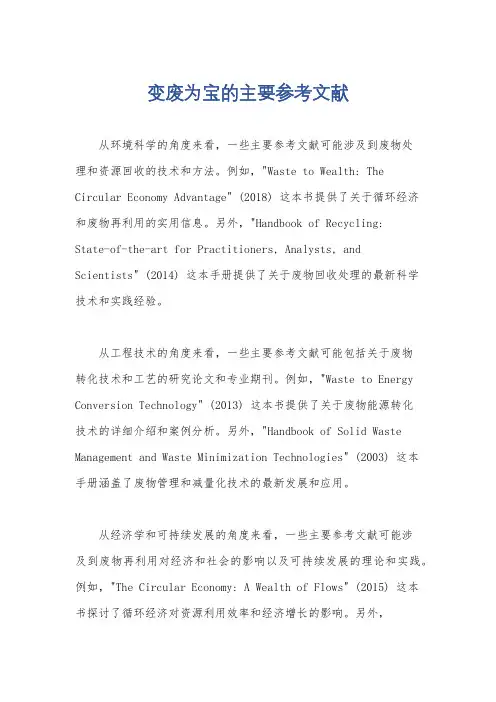
变废为宝的主要参考文献从环境科学的角度来看,一些主要参考文献可能涉及到废物处理和资源回收的技术和方法。
例如,"Waste to Wealth: The Circular Economy Advantage" (2018) 这本书提供了关于循环经济和废物再利用的实用信息。
另外,"Handbook of Recycling:State-of-the-art for Practitioners, Analysts, and Scientists" (2014) 这本手册提供了关于废物回收处理的最新科学技术和实践经验。
从工程技术的角度来看,一些主要参考文献可能包括关于废物转化技术和工艺的研究论文和专业期刊。
例如,"Waste to Energy Conversion Technology" (2013) 这本书提供了关于废物能源转化技术的详细介绍和案例分析。
另外,"Handbook of Solid Waste Management and Waste Minimization Technologies" (2003) 这本手册涵盖了废物管理和减量化技术的最新发展和应用。
从经济学和可持续发展的角度来看,一些主要参考文献可能涉及到废物再利用对经济和社会的影响以及可持续发展的理论和实践。
例如,"The Circular Economy: A Wealth of Flows" (2015) 这本书探讨了循环经济对资源利用效率和经济增长的影响。
另外,"Sustainable Solid Waste Management" (2015) 这本书提供了关于可持续固体废物管理的经济和社会影响的分析和案例研究。
总之,变废为宝涉及到多个学科领域,因此主要参考文献也涵盖了环境科学、工程技术、经济学和可持续发展等多个方面的研究成果和实践经验。

废杂铜冶炼渣中铜资源有效回收方案废杂铜冶炼渣中铜资源有效回收方案废杂铜冶炼渣中含有一定量的铜资源,有效回收这些资源可以减少资源浪费,并且对环境具有积极作用。
下面将逐步介绍废杂铜冶炼渣中铜资源的有效回收方案。
第一步:渣料预处理首先,需要对废杂铜冶炼渣进行预处理。
这包括对渣料进行筛分和磁选,以去除其中的杂质和磁性物质。
筛分可以将较大颗粒的渣料分离出来,而磁选可以去除含有磁性物质的渣料,使得后续步骤更为高效。
第二步:酸浸提取接下来,将经过预处理的渣料进行酸浸提取。
这一步骤可以利用酸性溶液中铜与渣料中的铜发生反应,将铜离子溶解在溶液中。
常用的酸浸剂包括硫酸和盐酸。
酸浸提取的条件如溶液浓度、反应时间和温度等需要根据具体情况进行优化调节,以提高铜的溶解效率。
第三步:溶液处理经过酸浸提取后,得到含有铜离子的溶液。
为了进一步提取和回收铜资源,需要对溶液进行处理。
常见的处理方法包括电解、溶剂萃取和水热法等。
电解是最常用的方法之一,通过在电解槽中施加电场,使得铜离子在阳极上还原成纯铜。
溶剂萃取则是利用有机溶剂将溶液中的铜离子萃取出来,然后通过脱溶剂和再溶剂两个步骤将铜离子从有机相转移到水相,最终得到纯铜。
而水热法则是利用水热条件下的化学反应,通过添加特定试剂将溶液中的铜离子转化成稳定的铜化合物或纳米颗粒,然后通过过滤或离心等操作得到纯铜。
第四步:铜产品制备最后,通过对溶液进行干燥、熔炼等处理,可以得到纯度较高的铜产品。
这些铜产品可以进一步加工,例如铸造成铜坯、制备铜粉等,以满足不同的应用需求。
通过以上步骤,废杂铜冶炼渣中的铜资源可以得到有效回收。
这不仅可以减少资源浪费,降低环境污染,还可以提高资源利用效率,促进可持续发展。
因此,对废杂铜冶炼渣中的铜资源进行有效回收具有重要的经济和环境意义。
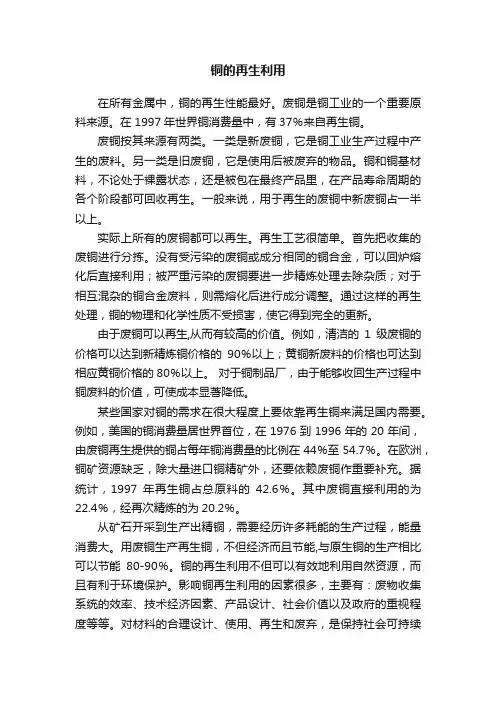
铜的再生利用在所有金属中,铜的再生性能最好。
废铜是铜工业的一个重要原料来源。
在 1997年世界铜消费量中,有37%来自再生铜。
废铜按其来源有两类。
一类是新废铜,它是铜工业生产过程中产生的废料。
另一类是旧废铜,它是使用后被废弃的物品。
铜和铜基材料,不论处于裸露状态,还是被包在最终产品里,在产品寿命周期的各个阶段都可回收再生。
一般来说,用于再生的废铜中新废铜占一半以上。
实际上所有的废铜都可以再生。
再生工艺很简单。
首先把收集的废铜进行分拣。
没有受污染的废铜或成分相同的铜合金,可以回炉熔化后直接利用;被严重污染的废铜要进一步精炼处理去除杂质;对于相互混杂的铜合金废料,则需熔化后进行成分调整。
通过这样的再生处理,铜的物理和化学性质不受损害,使它得到完全的更新。
由于废铜可以再生,从而有较高的价值。
例如,清洁的1级废铜的价格可以达到新精炼铜价格的90%以上;黄铜新废料的价格也可达到相应黄铜价格的80%以上。
对于铜制品厂,由于能够收回生产过程中铜废料的价值,可使成本显著降低。
某些国家对铜的需求在很大程度上要依靠再生铜来满足国内需要。
例如,美国的铜消费量居世界首位,在1976到1996年的20年间,由废铜再生提供的铜占每年铜消费量的比例在44%至54.7%。
在欧洲,铜矿资源缺乏,除大量进口铜精矿外,还要依赖废铜作重要补充。
据统计,1997年再生铜占总原料的42.6%。
其中废铜直接利用的为22.4%,经再次精炼的为20.2%。
从矿石开采到生产出精铜,需要经历许多耗能的生产过程,能量消费大。
用废铜生产再生铜,不但经济而且节能,与原生铜的生产相比可以节能80-90%。
铜的再生利用不但可以有效地利用自然资源,而且有利于环境保护。
影响铜再生利用的因素很多,主要有:废物收集系统的效率、技术经济因素、产品设计、社会价值以及政府的重视程度等等。
对材料的合理设计、使用、再生和废弃,是保持社会可持续发展的重要内容。
3.铜与环境铜以多种形式天然地存在于环境中。
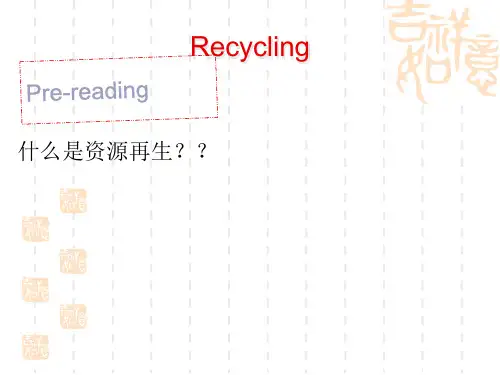
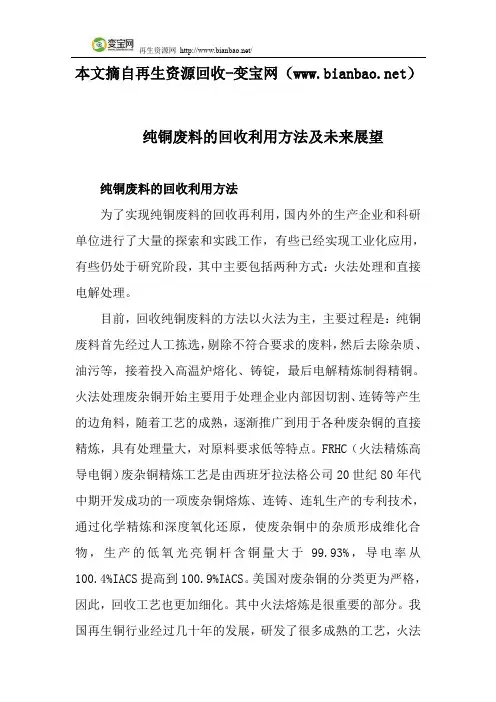
本文摘自再生资源回收-变宝网()纯铜废料的回收利用方法及未来展望纯铜废料的回收利用方法为了实现纯铜废料的回收再利用,国内外的生产企业和科研单位进行了大量的探索和实践工作,有些已经实现工业化应用,有些仍处于研究阶段,其中主要包括两种方式:火法处理和直接电解处理。
目前,回收纯铜废料的方法以火法为主,主要过程是:纯铜废料首先经过人工拣选,剔除不符合要求的废料,然后去除杂质、油污等,接着投入高温炉熔化、铸锭,最后电解精炼制得精铜。
火法处理废杂铜开始主要用于处理企业内部因切割、连铸等产生的边角料,随着工艺的成熟,逐渐推广到用于各种废杂铜的直接精炼,具有处理量大,对原料要求低等特点。
FRHC(火法精炼高导电铜)废杂铜精炼工艺是由西班牙拉法格公司20世纪80年代中期开发成功的一项废杂铜熔炼、连铸、连轧生产的专利技术,通过化学精炼和深度氧化还原,使废杂铜中的杂质形成维化合物,生产的低氧光亮铜杆含铜量大于99.93%,导电率从100.4%IACS提高到100.9%IACS。
美国对废杂铜的分类更为严格,因此,回收工艺也更加细化。
其中火法熔炼是很重要的部分。
我国再生铜行业经过几十年的发展,研发了很多成熟的工艺,火法处理主要包括反射炉工艺、倾动炉工艺和卡尔多炉工艺反射炉熔炼废杂铜时,在氧化阶段可进一步脱除其中的杂质,但其自动化程度不高,环境污染严重。
倾动炉在熔炼的不同阶段可倾斜炉体,便于通入气体和排除熔渣,但具有炉体结构复杂的缺点。
卡尔多炉工艺是一种强氧化熔炼方法,对原料要求低,不仅能够处理纯铜废料,甚至可处理铜含量20%~60%的废杂铜。
但因其炉子寿命短、成本高,未能得到大规模应用。
然而,纯铜废料熔铸是高耗能过程,若能够省略熔铸过程,直接进行电解精炼生产精炼铜或铜粉,不仅可以大大节约能源消耗,而且可减少环境污染。
有学者进行了纯铜废料的直接电解回收,取得了较好的效果。
但迄今,尚未有废杂铜直接电解工艺实现工业化生产,其中很重要的一个原因是:对直接电解过程中的流场、浓度场、温度场研究不够深入,致使实验室直接电解实验难以实现放大化生产。

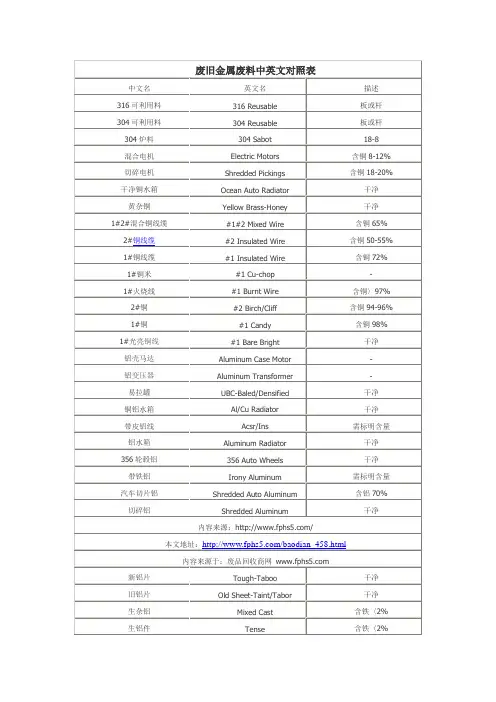
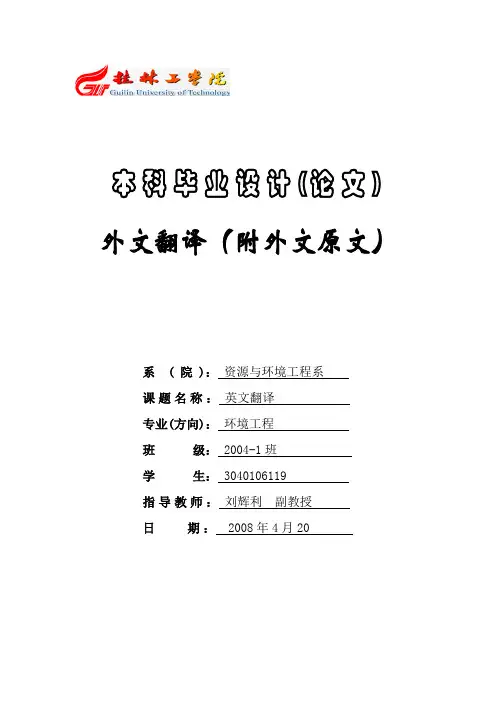
本科毕业设计(论文) 外文翻译(附外文原文)系 ( 院 ):资源与环境工程系课题名称:英文翻译专业(方向):环境工程班级:2004-1班学生:3040106119指导教师:刘辉利副教授日期:2008年4月20使用褐煤(一种低成本吸附剂)从酸性矿物废水中去除和回收金属离子a. 美国, 大学公园, PA 16802, 宾夕法尼亚州立大学, 能源部和Geo 环境工程学.b. 印度第80号邮箱, Mahatma Gandhi ・Marg, Lucknow 226001, 工业毒素学研究中心, 环境化学分部,于2006 年5月6 日网上获得,2006 年4月24 日接受,2006 年3月19 日;校正,2006 年2月15 日接收。
摘要酸性矿物废水(AMD), 是一个长期的重大环境问题,起因于钢硫铁矿的微生物在水和空气氧化作用, 买得起包含毒性金属离子的一种酸性解答。
这项研究的主要宗旨是通过使用褐煤(一种低成本吸附剂)从酸性矿水(AMD)中去除和回收金属离子。
褐煤已被用于酸性矿水排水AMD 的处理。
经研究其能吸附亚铁, 铁, 锰、锌和钙在multi-component 含水系统中。
研究通过在不同的酸碱度里进行以找出最适宜的酸碱度。
模拟工业条件进行酸性矿物废水处理, 所有研究被进行通过单一的并且设定多专栏流动模式。
空的床接触时间(EBCT) 模型被使用为了使吸附剂用量减到最小。
金属离子的回收并且吸附剂的再生成功地达到了使用0.1 M 硝酸不用分解塔器。
关键词:吸附; 重金属; 吸附; 褐煤; 酸性矿物废水处理; 固体废料再利用; 亚铁; 铁; 锰。
文章概述1. 介绍2. 材料和方法2.1. 化学制品、材料和设备3. 吸附步骤3.1. 酸碱度最佳化3.2. 固定床研究3.2.1 单一栏3.2.2 多栏4. 结果和讨论4.1. ZPC 和渗析特征4.2 酸碱度的影响4.3. Multi-component 固定吸附床4.3.1 褐煤使用率4.4. 吸附机制4.5. 解吸附作用研究5. 结论1. 介绍酸性矿物废水(AMD) 是一个严重的环境问题起因于硫化物矿物风化, 譬如硫铁矿(FeS2) 和它的同素异形体矿物(α-FeS) 。
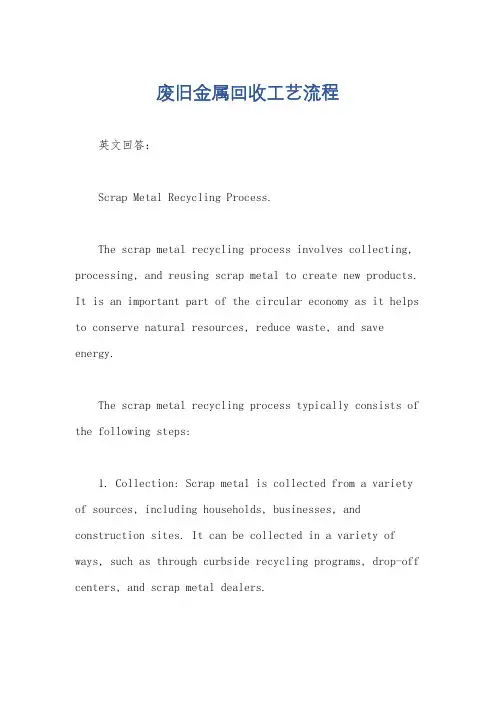
废旧金属回收工艺流程英文回答:Scrap Metal Recycling Process.The scrap metal recycling process involves collecting, processing, and reusing scrap metal to create new products. It is an important part of the circular economy as it helps to conserve natural resources, reduce waste, and save energy.The scrap metal recycling process typically consists of the following steps:1. Collection: Scrap metal is collected from a variety of sources, including households, businesses, and construction sites. It can be collected in a variety of ways, such as through curbside recycling programs, drop-off centers, and scrap metal dealers.2. Processing: Scrap metal is processed to remove contaminants and prepare it for recycling. This may involve sorting, shredding, and baling the metal.3. Melting: The scrap metal is melted in a furnace to create a molten metal alloy.4. Refining: The molten metal alloy is refined to remove impurities and create a pure metal product.5. Casting: The pure metal product is cast into new products, such as ingots, bars, or sheets.6. Manufacturing: The new metal products are used to manufacture a variety of products, such as cars, appliances, and machinery.中文回答:废旧金属回收工艺流程。
英语作文-废弃物资源化利用方案In the modern world, waste management has become a critical environmental challenge. The traditional approach of 'take, make, dispose' is no longer sustainable, and there is a pressing need for innovative solutions that can turn waste into resources. This essay explores a comprehensive plan for the resource utilization of waste, focusing on reducing environmental impact while creating economic value.The cornerstone of waste resource utilization is the concept of a circular economy, where products and materials are recycled and reused to the greatest extent possible. This approach contrasts sharply with the linear economy, which ends in disposal. To implement a circular economy, we must first understand the types of waste we produce and then devise strategies to repurpose them.Household Waste: The average home generates a variety of waste, including paper, plastic, glass, and organic matter. Paper and glass can be recycled, while plastic can be both recycled and repurposed into new products. Organic waste, on the other hand, presents an opportunity for composting, which can transform it into nutrient-rich soil for agriculture.Industrial Waste: Industries produce waste that can be hazardous. However, with proper treatment, even these can be converted into useful materials. For example, fly ash from power plants can be used in the construction industry to make bricks and cement.Electronic Waste: E-waste is a growing concern due to the rapid obsolescence of electronic devices. Recycling e-waste not only recovers valuable metals like gold and copper but also prevents harmful substances from polluting the environment.To facilitate the resource utilization of waste, several steps can be taken:1. Education and Awareness: Educating the public about the importance of waste segregation is crucial. When waste is properly separated at the source, it becomes easier to process and recycle.2. Incentives for Recycling: Financial incentives can encourage more people and businesses to recycle. Subsidies or tax breaks for companies that use recycled materials can also promote a market for such products.3. Innovation in Recycling Technologies: Investment in new technologies can lead to more efficient recycling processes. For instance, advancements in biotechnology have the potential to improve the breakdown of organic waste into biofuels.4. Legislation and Policy: Governments play a vital role in waste resource utilization. By enacting laws that mandate recycling and penalize wasteful practices, they can ensure that businesses and individuals contribute to a sustainable future.5. Collaboration: Partnerships between different sectors of society can lead to better waste management solutions. For example, a collaboration between a city's waste management department and a local university can lead to innovative research on waste repurposing.In conclusion, the resource utilization of waste is not just an environmental imperative but also an economic opportunity. By adopting a circular economy model, we can minimize our ecological footprint and create a sustainable future. It requires a concerted effort from individuals, businesses, and governments to change the way we view and handle waste. With the right strategies and commitment, what was once considered waste can become a valuable resource for generations to come.。
废纸回收利用英文作文Title: The Importance of Paper Recycling。
In today's world, environmental conservation has become a pressing concern. Among the various methods of reducing waste and preserving natural resources, paper recycling stands out as a significant practice. Recycling paper not only mitigates the depletion of forests but also minimizes energy consumption and reduces greenhouse gas emissions. In this essay, we will delve into the importance of paper recycling and explore its benefits for the environment.Firstly, let us consider the environmental impact of paper production. The process of making paper from virgin pulp involves the felling of trees, which contributes to deforestation and habitat loss for numerous species. Moreover, the production of paper consumes vast amounts of water and energy, leading to pollution and resource depletion. By recycling paper, we can alleviate these detrimental effects on the environment.Paper recycling conserves trees, which are vital for maintaining ecological balance and biodiversity. Trees play a crucial role in carbon sequestration, absorbing carbon dioxide from the atmosphere and mitigating climate change. By reducing the demand for virgin pulp, paper recycling helps to preserve forests and their invaluable ecosystem services.Additionally, recycling paper saves energy compared to producing paper from raw materials. The recycling process requires less energy and generates fewer greenhouse gas emissions than manufacturing paper from scratch. By reducing energy consumption and emissions, paper recycling contributes to mitigating climate change and reducing air pollution.Furthermore, paper recycling reduces the amount of waste sent to landfills or incinerators. Paper waste comprises a significant portion of municipal solid waste, and its decomposition in landfills generates methane, a potent greenhouse gas. By diverting paper from landfillsthrough recycling, we can minimize methane emissions and prolong the lifespan of landfill sites.Moreover, paper recycling conserves water, a precious resource essential for various ecosystems and human activities. The production of paper from virgin pulp involves significant water usage, including in the pulping and bleaching processes. By recycling paper, we can reduce the need for freshwater in paper production, thus alleviating pressure on water resources.In addition to its environmental benefits, paper recycling offers economic advantages as well. Recycling paper creates jobs in collection, sorting, processing, and manufacturing, contributing to local economies and fostering sustainable development. Moreover, recycling reduces the costs associated with waste disposal and raw material extraction, making it a cost-effective solution for businesses and municipalities.To maximize the impact of paper recycling, it is essential to raise awareness and promote recyclingpractices among individuals, businesses, and communities. Education and outreach programs can inform people about the benefits of paper recycling and provide guidance on proper recycling techniques. Furthermore, governments can implement policies and incentives to encourage recycling and support the development of recycling infrastructure.In conclusion, paper recycling plays a crucial role in environmental conservation and sustainable development. By conserving trees, saving energy, reducing waste, and conserving water, paper recycling helps to protect the environment and mitigate climate change. Moreover, paper recycling offers economic benefits and createsopportunities for job creation and sustainable growth. Therefore, promoting paper recycling is essential for building a more sustainable and resilient future for our planet.。
废杂铜利用技术状况对废杂铜的利用要经过对废电线电缆、电机和五金电器等铜制品的拆解、废铜分选和利用等几个环节。
国外对废金属回收拆解是一个相当成熟的产业,从金属拆解、分选、打包、运输,全部为自动化的机械设备。
而我国的废铜拆解业是典型的劳动密集型行业,很少使用机械,大部分采用手工操作。
因此该行业的进入门坎很低,没有技术限制。
杂铜最合理的利用方案是将其直接冶炼成铜合金,这样原料中所有的有价成分都回收到成品中了,但此法对原料的要求比较高。
我国收集的杂铜原料杂质含量较多、较杂,直接利用的难度比工业发达的国家大得多,因此近一半的国内收集和国外进口的废杂铜不得不采用火法熔炼技术生产再生铜。
火法熔炼生产再生铜工艺目前有三种不同的流程,即一段法、二段法和三段法。
一段法处理含铜较高的紫杂铜、黄杂铜和电解残极等,铜品位均大于98%。
将原料直接加入精炼炉内,经熔化、氧化、还原等火法精炼后铸成阳极板,再电解精炼得到电解铜。
二段法是将废杂铜在熔炼炉内先进行熔化并吹炼成粗铜,粗铜再在精炼炉精炼成阳极板。
三段法是将废杂铜经鼓风炉熔炼--转炉吹炼--精炼炉精炼产出阳极板。
三段法具有原料的综合利用好和设备生产率较高等优点,但过程复杂、设备多、投资大且燃料消耗多,故该法多用于大规模生产和处理某些废渣。
目前我国企业利用废杂铜生产再生铜大多采用一段法和二段法。
我国企业采用二段法生产再生铜采用的是反射炉,国内首家使用国外先进炉型倾动炉精炼废杂铜的工厂是江西铜业公司贵溪冶炼厂,于2003 年投入生产,生产环境和作业强度都优于传统的固定式反射炉。
此外,我国企业大量采用黄铜废料直接生产铜杆、铜线、合金管等低档次的铜加工材,有50%的国内收集和进口的废杂铜是通过这种方式直接利用的。
废铜利用的一般化工流程英文回答:General Chemical Process for Copper Recycling.Copper recycling involves a series of chemical processes to extract copper from scrap and waste materials. The general process can be summarized as follows:1. Collection and sorting: Scrap copper is collected from various sources, such as discarded electrical wires, electronic appliances, and construction sites. It is then sorted and classified based on its grade and purity.2. Pretreatment: The scrap copper is often contaminated with impurities and non-copper materials. Pretreatment involves removing these impurities through processes such as crushing, shredding, and magnetic separation.3. Smelting: The pretreated copper is smelted infurnaces to remove impurities and recover the copper metal. The smelting process involves heating the copper in the presence of oxygen to oxidize impurities, which rise to the surface as slag.4. Refining: The smelted copper is further refined to remove remaining impurities and enhance its purity. Refining methods include electrorefining, pyrorefining, and hydrometallurgical processes.5. Casting and forming: The refined copper is cast into ingots or various shapes for further processing or use. It can be rolled into sheets, drawn into wires, or cast into components.中文回答:废铜利用的一般化工流程。
附录A 外文翻译-原文部分Recycling of scrap copperChina as the largest developing country in the world, in realizing industrialized process especially in keeping Tao Min economy in the process of rapid development of non-ferrous metals demand is very, especially copper its supply is very tight. Copper shortage is to restrict our country copper processing industry is one of the main factors. The 2011 world copper output is 20000000 t about, among them 85% to 90% from the copper extraction and smelting out 10% ~ 15% from Cu recycling. So the copper recycling industry becom the important way for copper resources shortage.In view of present situation of copper scrap copper resources and Renewable investment, low energy consumption and cost, little pollution and has simple process and other characteristics, copper scrap recycling in China by mushroom considered.1 Chinese copper demand and resource status1.1 Chinese copper demandAt present, China has become the world's largest consumer of copper, copper processing industry manufacturing base and the copper base product export country. Our country is in the world of refined copper consumption growth is the rapiddest, the average growth rate is2.4 times of world, especially since 2000, an average annual increase of about300000 t, become pull move consumption growth in the major countries of world copper. Copper are mainly used for electric power, electrical and electronics, machinery manufacturing, construction, transportation and other industries. With the rapid development of automobile industry, the state of rural electrified wire netting transform, especially copper shortage. In 2010December the national development and Reform Commission report, in construction, automotive and other industries to speed the development of drive, China copper consumption showed a steady upward trend, demand growth is much higher than the growth rate of the Chinese alligator.1.2 of China's copper resourcesCopper resources shortage is China's copper industry the most outstanding problem, industry of our country copper smelting capacity greatly exceeds the guarantee ability of copper concentrate. China's copper base reserves30420000 resources, resources total 62180000t. Copper mine reserves and foreign comparable part, not exceeding 18000000 t12J, ranking seventh in the world. But from tell on the whole, the copper resources in China is still very poor ( Especially the lack of rich copper ), and foreign copper resource countries still have quite big difference. China's domestic copper concentrate supply is less than 30%, more than 70% of the need to rely on imports.Copper resources in China is characterized by small deposits, large, superlarge deposit less. The characteristics of the hill of our country copper mine constructiondimensions slants generally small, and after several decades of intensive mining, their reserves at a substantially reduced, some even have almost been exhausted. Notably, China's copper reserves most of them have been developed, the future there is a part of capacity to disappear.Resource of our country copper is another characteristic of ore, ore less, complex polymetallic ore, copper ore less single. The average grade of 0.78% copper, copper grade of more than 1% high grade copper reserves accounted for only36%, and the Underground mine, open pit mine is little, poor mining conditions.China's copper resources are very unevenly distributed, mainly in the southwest of Sanjiang, Yangtze River, southeast is coastal, Qin Qikun metallogenic belt and Jilin and Liaoning Eastern Gangdese metallogenic belt, Tibet. To provide alternative resources mining is mostly located in economy relatively backward center-west region, exterior construction condition difference, scale mining requires a certain amount of time, so the mine production of copper mineral of copper content to increase, will gradually decline.2 recycling of scrap copper statusAccording to the China Nonferrous Metals Industry Association, in 2004, China's recycling scrap copper1160000 T, occupy the copper consumption 28%, not including copper and copper products factory direct recycle corner than expected and the imperfection of about 1000000 t.2004domestic recycling copper360000 T,171 into the copper scrap3960000t (equivalent to belong to base800000 t ). According to the 2003China copper raw materials and products in the V1number display of copper into the F1growth is the rapiddest, reached 25%, copper concentrate in8% VI growth, cathode copper into a 12% fall in El. In 2006 I because of refined copper output is 3000000 T, and scrap copper include N and gang in the recovery of the already amounted to 5620000 t ( copper scrap metal Dong a total of approximately1680000 t ). Copper scrap recycling and trading status of copper market will produce bigger and bigger effect.China's most economically developed areas in the Yangtze River Delta, Pearl River Delta, Bohai is the most in short supply of copper mineral resources in the region, is also our country renewable copper and copper processing production the biggest area. 80% of the country's copper processing enterprises located in three regions,75% of the country's annual recycling of scrap copper. The three to ninth regenerated copper industry has its own characteristics: the Pearl River Delta region are mainly imported waste dismantling, classification, sales copper materials; Yangtze River Delta IX represented Zhejiang, the use of copper production of copper and brass products; of area of annulus Bohai mainly in Tianjin, has more than 200warehouse industry the use of copper wire and cable production. In the copper use, can be divided into direct and indirect use of two by According to estimation, copper by plus J:, about L / 3to fine copper returned form market, namely through the anode furnace smelting production of electrolytic copper, often called the regeneration of copper; the other2/ 3with a refined copper or copper alloy form Xia new A connection for use, production of copper or copper alloy products.3 copper scrap classificationCopper according to the different stages, can be divided into: industrial production process resulting in a copper, produced during the processing of new copper, consumers use after the old copper three class;(1) a copper. As substandard anode cathode and anode material, waste. These wastes are not deep processing or selling, it is usually to return to the previous step, substandard copper usually Xia new return export converter or anode furnace for refining, defective material is melting and recasting.(2) The new copper. New copper refers to new trim or internally generated copper factory. This copper is produced during machining, it with a copper the main difference lies in the alloy or covering of CHO could have been doped.(3) The old copper. The old copper is abandoned, used or externally generated scrap copper. It comes from has reached its limit the use of the product.According to scrap copper copper amount is different, also can be divided for copper:(1) The L copper. This copper copper in the lowest content is 99%, the minimum diameter or thickness of 1.6 mm. L copper including cable," heavy" copper ( cutting chip, chip, a bus bar piercing ) and wire nodules.(2) No. 2copper. This copper copper in the minimum content of 96%, with the line, heavy copper or nodular form, and contains several other restrictions.(3) low copper. The minimum amount of copper scrap copper92%, the composition of pure copper, pure copper surface paint or coating (drain pipes,) or had been heavily oxidized (4) refining brass products. This include various types of components in mixed alloy of copper, the minimum amount of copper is 61.3%, other less restrictive.(5) Copper containing waste. This type includes all low copper content of raw materials, such as slag, slag, sludge, return material, powder and other waste.4copper processing4.1wire and cable processingWire and cable so far is the old copper in a most general kind. Scrap wire, cable recycling is mainly to make copper wire and an insulating layer separation, there are four main ways: (1) mechanical separation, the law can be divided into two types. The debarking machine processing method, this method is suitable for processing the thickness of basically the same wires. This process has the following characteristics: can be used for comprehensive recovery of scrap wire and cable and copper in an embedding material, comprehensive utilization level is higher; the output of the copper shavings contain substantially no plastic, reducing the melting plastic pollution of the atmosphere; and has the advantages of simple process, easy to mechanization and automation; process higher electricity consumption, the blade wear. The method is suitable for processing thick cables and wires. (2) Iow temperature freezing method, low temperature processing waste recycling metals and insulators in the process themethod is suitable for processing various sizes of wires and cables. Waste wire by freezing insulation layer is brittle, then the broken insulating layer and copper separation. (3) Chemical stripping method. Using an organic solvent of the wire insulation layer is dissolved away, this method can produce high-quality copper, thismethod is to find an effective and cheap solvent. (4) The thermal decomposition method, the United States Patent No. 4040865was proposed by using the method of thermal decomposition insulating layer obtained after burnCopper wire.4.2 car scrap recyclingChina's automobile waste quantity along with the car retains the quantity increases sharply. These vehicles will be accumulated elimination, scrapped, the still has tens of thousands of home every year tens of millions of tons of vehicle garbage. Other countries have to transfer to China Auto trash situation. Vehicle g arbage may be recycled resources are very rich, of which there are 3Cho copper recycling potential resources.The first is open collector, in broken before it has been separated from the car manual. Radiator accessories the tin lead solder, this requires the use of radiator parts remelting and refining, in order to obtain pure copper. However, using different solder or brazing new assembly technology can directly from the radiator or heater zero Components without the need for refining. This kind of radiator of copper call charge utilization rate is close to100%.A car is scrapped in the waste steel and iron separation out after the rest of the nonferrous metal scrap scrap copper second source. Nonferrous metal scrap metal: there are three main types of aluminum, copper and zinc. But the automobile circuit is mainly composed of copper wire. From the non-ferrous metal waste separation of copper with several methods, such as hand picked, air filter and heavy medium separation.Finally, a source of copper metal separation cracked residue. This residue is mainly composed of dust and organic matter composition -- the dashboard and steering wheel, plastic cushion, carpet and fabric fluff. The residue includes up to 3% copper and some oil value.4.3 electronic waste processingElectronic waste is the two copper in a rapidly growing. Is now vigorously develop the recycling of the raw material of copper technology. Electronic waste is defined as the production of electronic hardware wastes and discarded used electronic products. Because of this, it includes the old copper and copper.The overall composition of electronic scrap Cho to fall into three categories: (1) plastic (2) refractory oxide; (3) metal The metal is approximately half the copper, also contains several base considerable gold and silver.The separation of metal from electronic waste and become" ore processing" method of similarity. The method is similar to automobile scrap recycling, namely: to facilitate the recovery of large split; broken in order to reduce the residual material size; separating metal from plastics and ceramics.5ConclusionChina's copper scrap recycling also has many of the problems to be solved.(1) Iow grade copper scrap to flood the market. China's imports of copper scrap mostly low grade scrap copper, such as discarded cables, electrical equipment, i.e. without pretreatment of useless miscellaneous copper, while imports after the selection after the No. 1, No. 2copper is relatively less. Recommended strict copper imports of quality, amount of imports of scrap copper.(2) The serious pollution to the environment. As a result of our country scrap copper enterprises belong to the collective or private enterprises, these enterprises to fully to copper scrap as raw material, using simple production process for smelting recycled, thus the environment causes serious pollution. Suggestion: 1. The scrap copper processing using, especially the major scrap copper center of environmental protection departments to strictly implement the state environmental regulations, strengthen supervision, propaganda, such as further formulate relevant provisions, resolutely banned the burningof waste electric wires cables in the hair wire; no impurity containing too much copper scrap ( copper content below 90%) direct smelting furnace, so as to avoid large area of air pollution. The gradual improvement of scrap copper base copper scrap management, improve the quality of employees, strengthen the consciousness of environmental protection. The strictCan use scrap copper direct production of black rod, national classics trade appoint already will produce the black rod technology as an out process, the relevant departments should supervise the implementation.(3) The production technology and equipment behind. China's scrap copper production enterprises not only quantity, small scale, manage dispersive, backward technology and equipment, and large energy consumption, low utilization rate of resources recycling. Suggestion: the elimination of backward technology, the introduction of advanced production equipment.(4) Iack of resources, serious waste. China's shortage of mineral resources, prospecting difficulty is big, the main mineral shortage, in a short period of time is difficult to improve, it must be imported large quantities of scrap copper to make up the gap. According to statistics, China mineral resources recovery rate of only 30%, and associated mineral resources comprehensive utilization rate of less than 20%, and foreign average above 50% in. As the level of science and technology is backward, resource products in the subsequent use of process efficiency, at present, our country to create a unit of GDP energy consumption and raw material is developed several times to several times. Geological administrative lag, management of mineral resources is relatively weak, some mineral resources development and utilization of order disorder, collect rich abandon poor, resulting in a tremendous waste of resources. Suggestion: cherish the resources, the importance of renewable. Effective use of existing copper resources, expansion of copper natural resources can use range.附录B 外文翻译-译文部分废杂铜的回收与利用我国作为世界上最大的发展中国家,在实现工业化的过程中尤其是在保持陶民经济快速发展的过程中对有色金属的需求十分强劲,特别是铜,其供应十分紧张。